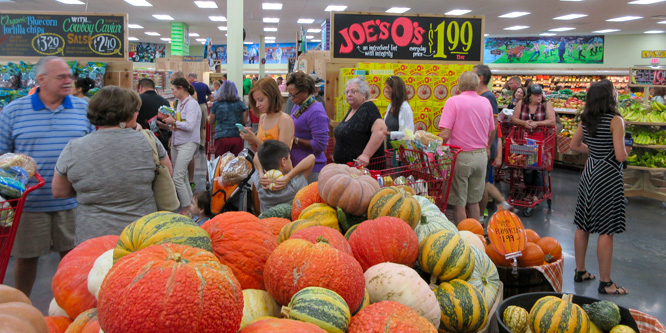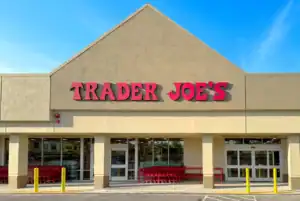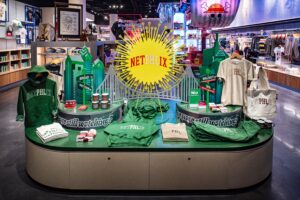
Photo: Getty Images/PeopleImages
November 11, 2022
Is Trader Joe’s success formula becoming obsolete?
Through a special arrangement, presented here for discussion is an excerpt of a current article from Frozen & Refrigerated Buyer magazine.
With its high-quality products, value proposition and knowledgeable and friendly staff, Trader Joe’s often finds itself at or near the top of various industry “best of” lists. However, the quirky chain may still face some challenges as it expands.
An obvious potential shortcoming is not offering e-commerce as e-grocery has taken off. Beyond challenges associated with attempting curbside pickup in a Trader Joe’s parking lot, the grocer doesn’t want customers ordering online because it takes away from the store experience. Trader Joe’s president of stores Joe Basalone said in a recent interview with Kitchn, “For us, the brand is too important, and the store is our brand.”
Karen Kelso, VP of retail insights for mass and club at Kantar, agrees Trader Joe’s in-store experience is “a fundamental part of its brand,” but also said Kantar’s data shows “commerce and omnichannel options are firmly embedded in shopper preferences, and this is a long-term, sustained trend that we don’t expect to change.”
Ms. Kelso also believes some improvements in the area of logistics and supply chain would help Trader Joe’s maintain a more consistent supply of high demand items.
Supply chain disruptions could have an outsized impact on Trader Joe’s compared to other retailers. Jim Hertel, SVP at Inmar Intelligence, observes, “In small-format limited assortment stores, each SKU plays a disproportionately important role because there aren’t as many substitutes on the shelf. What’s more, the many unique items in Trader Joe’s range with destination appeal mean that out-of-stock items are that much more meaningful to shoppers and that much more difficult to source from other suppliers.”
Trader Joe’s lacks a loyalty card that could provide customer data and its EDLP strategy removes the thrill of deal-hunting shoppers may find at other grocers. Gary Stibel, founder of New England Consulting Group, however, believes “the lack of promotion actually reinforces the value proposition.”
Inflation could be beneficial as shoppers trade down from places such as Whole Foods, but also a challenge. Said Neil Saunders, managing director at GlobalData Retail, “Trader Joe’s needs to walk a tightrope between maintaining its margins and maintaining its reputation for value.”
Discussion Questions
DISCUSSION QUESTIONS: What do you think Trader Joe’s needs to work on? Will the lack of e-commerce, a loyalty program or discounts found at other grocers become bigger liabilities for the chain down the road?
Poll
BrainTrust
Georganne Bender
Principal, KIZER & BENDER Speaking
Jamie Tenser
Retail Tech Marketing Strategist | B2B Expert Storytelling™ Guru | President, VSN Media LLC
Dr. Stephen Needel
Managing Partner, Advanced Simulations
Recent Discussions







The lack of e-commerce at Trader Joe’s may not to be everyone’s preference. However the proposition is so strong across so many attributes – value, quality, taste, uniqueness of offer – that most consumers are willing to overlook this and visit stores. This shows up in Trader Joe’s strong trading numbers over the past few years: it has gained market and shopper share. The other point to make is that e-commerce in grocery is rarely profitable. So Trader Joe’s could implement something and end up damaging its business model which relies on low prices and high volumes sold from stores. As for loyalty programs: largely these are not about loyalty – they are about gathering customer data so again, not having one is not that detrimental to the customer experience.
The store experience is the brand at Trader Joe’s. They are unequaled in their segment. The supply chain needs attention as the company has had many out-out-stocks recently for which customers have been loyally waiting. Some subtle forms of automation are also due, although one could understand that Trader Joe’s does not want to hurt their hand-holding customer service image by becoming more cold and impersonal.
I agree. Admittedly there is a relatively limited number of items we buy in their stores but several have been out of stock for months. The very friendly staff has told us to keep coming back to look for them because they have not been discontinued. We do so when going to the area where their local store is. No more special Trader Joe’s trips.
Who are you calling obsolete? Not every grocery store needs to be slick and shiny, and not every grocery store has to live and die by curbside pickup. Trader Joe’s has already proven that.
Trader Joe’s loyal customers are fine with the retailer’s quirks. The things that make shopping there different are what its customers love.
I like that they do not have e-commerce at Trader Joe’s. The stores are crowded already and it would be a big issue with those carts in the aisles. It’s fun to walk into the store and shop not knowing what you will find. I believe they need a loyalty program though – I think it would be a thank you to those that shopped the stores for years.
Trader Joe’s rationale has been that it offers the lowest price possible to customers on a day-in and day-out basis and that added expenses such as loyalty programs will only drive prices up.
The company counts on developing true loyalty with its customers, in the human sense, by offering products they value and backing them up with a no questions asked and no receipt required guarantee. It also excels at hiring people who are true brand ambassadors who customers value for their knowledge and willingness to help. If there was ever a retailer that didn’t need a loyalty program – Trader Joe’s is it.
The only real pain point for Trader Joe’s customers is the chain’s parking lots. There is a method to the madness there, as well. Crowded stores suggest that it isn’t being hurt too badly.
Trader Joe’s already has a loyalty program. It just doesn’t involve databases or data collection (and who knows if they may be doing some data we don’t know about on the back end with credit/debit card purchase data):
1. Satisfaction guarantee- you have a problem with an item, you get a refund, no questions asked and no hassle. You don’t even have to bring the product back.
2. Quick checkout. Efficient and friendly, every time. Every location.
3. Strong private label mix, very tight quality controls, and many very clean labels.
4. Fun to shop atmosphere.
5. Small store size making it easy to gather what you need quickly and easily.
6. Everyday low pricing. It really is low. Go price them on various categories vs. other grocers (or Walmart) and you will see Trader Joe’s comes in 20-30% cheaper on staple grocery items like coffee, milk, olive oil, bottled beverages, pasta, everything basically. And yes I am comparing private label to private label here.
I think Trader Joe’s has the best loyalty program in the grocery industry. It does right for the customer and makes it easy for the customer, every time they shop there.
Scanning that Kroger Plus Card or Safeway Club Card to pay high prices, have to deal with an app to get deals, have to argue with someone when the discounts don’t apply properly, hope the few good deals are actually in stock, as you check your items out yourself via a self checkout sounds more like a customer hassle program than a customer loyalty program.
As a long-time, loyal customer of Trader Joe’s, I will do my best to be objective. I love their assortments, I love the simplicity of EDLP: no apps, no coupons, and no loyalty card required. What you see is what you pay. Those two things have kept me coming back to their stores for more than 20 years. I am not convinced that offering online options diminishes their brand promise in any way. But they spend a lot more time and money thinking about those things than I do. So, as much as I would love to be able to order my TJ’s favorites through Instacart or DoorDash, I respect their decisions. And guess what? I rarely walk out of a Trader Joe’s store with only the things I had on my list when I entered the store. Their ability to constantly evolve their assortment with interesting temptations continues to impress me (and my taste buds). Maybe they know what they are doing by forcing me into the store to get my annual Candy Cane Joe Joe’s fix after all…
The biggest disconnect for Trader Joe’s is the inability to target its most profitable customers. For instance, the retailer doesn’t know for sure if a product it’s delisting is going to cause those shoppers to move to other stores or online. While they can conduct market basket analytics to get some answers, and I’m sure they do, the lack of a loyalty program inhibits them from really understanding what products the most profitable shoppers consider most important.
Also customers are advised to provide feedback regarding discontinued items and store teams are provided with channels to flow that feedback upstream. Many products have been returned after being discontinued, or seasonal products made year around products, due to that process.
They are old school in how they do things. They write orders by hand. They don’t have any security cameras in their stores. They definitely could improve various technology. They probably have higher shrink than they should have due to a lack of data to optimize ordering. But why change? Their formula works. The ownership is obviously satisfied with the profits the chain generates and they have constantly expanded and have the highest sales per square foot in the industry and it isn’t even close.
Also Trader Joe’s are not necessarily a weekly shop or every shopper’s primary store. They are not saturated in a market and just because someone doesn’t come to Trader Joe’s for a few weeks doesn’t mean they have moved on due to an item being discontinued. It may just mean they were not the 20-30 minutes from home to get to Trader Joe’s for a couple weeks.
There’s nothing obsolete about quality and value. But there is also no denying that Trader Joe’s needs to implement many of the evolutionary measures called out above. At some point they risk truly testing the patience of even their most die-hard fans and supporters.
Trader Joe’s isn’t broken and there’s no need to fix it. Its parking lots are full and its customers are enthusiastic. If customers want to frequent a store where the aisles are jammed by associates picking orders for customers at home, they can visit an Amazon Fresh.
The real boss here on how to do business is the consumer. So you don’t want customers ordering online? That is your call, but remember customers will do what they want. Customers today make the choices, as it always has been.
To be honest, I think Trader Joe’s is just fine. Obviously out-of-stocks are a challenge for them as they are for any retailer. Jim Hertel is right, to a point, but he’s not figuring in another component — Trader Joe’s customers’ fanatic loyalty and appreciate of the chain’s culture, which buys them more than their fair share of forgiveness. And I agree with Gary Stibel. EDLP pricing plus a lack of faux discounts through “loyalty programs” the only purpose of which is to gather data reinforces Trader Joe’s value proposition. As to ecommerce, we’ll see what they do. Right now it’s clearly not a deal breaker with consumers.
The benefits of Trader Joe’s have been focused on the quality and transparency of ingredients. While they were ahead of the curve, it seems the curve is catching up with more and more products at traditional retailers being offered with quality ingredients and organic alternatives that do not bear a huge price tag.
Trader Joe’s spectacular stores, private labels and people spark retail joy. Yet, shopping habits have changed. Today’s shopper is omnichannel and younger shoppers in particular expect digital options. Resisting omnichannel choice could harm the brand down the road as Gen Zs and Generation Alphas grow up.
I’ve wondered the same, Lisa. And my own unscientific poll among Gen Z customers is they don’t seem to care that TJ’s doesn’t offer digital options. That could change, of course.
The Albrecht family has done a terrific job of positioning Aldi and Trader Joe’s. As for a lack of an online shopping alternative, it really is inconsistent with its in-store shopping experience. As for loyalty programs, Trader Joe’s realizes that it is not customer loyalty that matters, but retailer loyalty to the customer which is king. How has Trader Joe’s maintained its loyalty to its customers? Simple – it delivers on its promises.
The article didn’t mention any specifics on Trader Joe’s problems. The commentary is about “let’s make Trader Joe’s like every other grocer.” The business model Trader Joe’s works within may be just right for Trader Joe’s. Without knowing their particular goals it’s hard to say what is or isn’t working for them. But when I’m in their new store under the bridge on First Avenue in NYC, I see over 30 cashiers at work to keep the shoppers coming through at an even and comfortable pace. The store is bustling and has all the positive characteristics of inventory and staff mentioned in the commentary. The question is, can an outlier continue to be successful?
There are lots of grocers with e-commerce, loyalty programs and discounts that aren’t having shoppers line up at more than three or four cashiers. That’s not a sign of success to me.
First, Trader Joe’s is a benchmark of value that other retailers should aspire to be like. They have good products, competitive pricing, and incredible service. That’s what keeps them in the game – and at the top of the game.
As for a loyalty program, Trade Joe’s already has one. It’s their customer experience. That’s what gets their customers to come back again and again.
There are other ways to get customer data outside of a loyalty program. If Trader Joe’s wants or needs that information, they will find ways to get it.
If anything, I always felt Trader Joe’s was expanding its footprint too slowly. I’ve waited 20 years for a Trader Joe’s I can shop at without it being a day trip! That day has finally come.
I don’t care as much about e-commerce, because Trader Joe’s with its poorly designed checkout stands, remains a real adventure that I actually enjoy.
Those poorly designed checkstands allow them to have more checkstands and more actual humans behind the registers to get the lines moving faster….
Those poorly designed checkstands also make it so you don’t have to stand there and unload your cart then re-load your cart at the end, like you do at a standard Safeway or Kroger.
Those poorly designed checkstands also take up significantly less space than standard grocery belted checkstands, so there is more room for merchandise.
I do agree they are a bit closer together than I’d prefer, but there are a lot of reasons.
Just keep the online pickers out of the aisles.
A great example of misapplying the results of research. Yes, it may well be true in most of our grocery shopping that we’d like to have omnichannel options. That doesn’t mean we want it in every venue (Trader Joe’s, Lidl, Aldi). Thinking like this from Kantar is why the grocery shopping experience is so homogeneous – every store is the same – and why these smaller alternatives are flourishing.
If Trader Joe’s truly believes store experience is part of its core value, then I suggest they look at the checkout and parking situations which are crowded and filled with obstacles at many stores. Shoppers go to Trader Joe’s because of the unique products — ensuring they are in-stock is critical, as is a pleasant beginning and end of the shopping trip.
Just a personal observation but I haven’t shopped Trader Joe’s since the COVID-29 shutdown – I have a friend bring the few things I can’t get elsewhere. But I do shop at the Aldi across the parking lot. What’s the difference? Wider aisles, better checkout, better ventilation/higher ceilings, smaller crowds, etc. And earlier during the shutdown I shopped Aldi via Instacart – finding new items I’d never noticed shopping in person prior to COVID-19. Aldi was there for me.
So in my humble opinion, I’m done with Trader Joe’s, they didn’t “serve my needs” when I was sheltering in place and my loyalty is with the other branch of the family at Aldi, plus Costco and even Walmart.
So back to the question — I’d say it’s never too late to admit a mistake of ego and start to offer e-grocery.
Trader Joe’s uses the same principle as its owner’s other store chain — Aldi. That is — less is more. Fewer SKUs, less price and less square footage. It also adds to localization with pics and drawings of local landmarks and concepts. Near my Boston area we have Paul Revere on a horse (advertising apples) and the Bunker Hill monument in the background. The combination with unique brands makes the concept an effective solution. People go to Trader Joe’s for their neighborhood store — and that blows away loyalty program discounts.
I’m a big fan of TJ’s and I totally appreciate the uniqueness of its merchandising approach and its commitment to simplicity in its operational model.
Adding ecommerce to the mix would increase operational costs and change the behavior of some shoppers — for better and worse.
It would be madness to try to cram online order fulfillment into its compact footprint locations.
But — and this is a big one — rigid retail formulas tend to become road-kill when the market throws them a curve. Shopper expectations are changing, and the absence of a digital option will be perceived by some as indifference to their preferences.
Trader Joe’s may not be able to detect this yet, since they collect no shopper loyalty data to track trends, but we can intuit that it affects shopper choices — especially among the younger cohorts.
What can this extraordinary retailer do? A dark-store ecommerce strategy might be a smart first play. No modification of existing stores would be needed to test this in a few markets. Existing distribution systems would work well. The learnings could be of immense strategic significance, and the experiment would be reversible if it proves unpopular with shoppers.
I suspect they would discover a whole cadre of shoppers who are attracted by both their exceptional merchandising and the digital option.
Good observation. A dark store approach could be the win that doesn’t interrupt in-store operations. And maybe only offer a small % of popular products online to encourage customers come back for discovery.
Could it be that Trader Joe’s doesn’t need to “work” on anything? I can’t be sure, of course, but TJ’s strikes me as possibly a good example of a concept that works for a certain reason, reaches a maximum size, and then … that’s it. Efforts to improve it or expand it aren’t going to accomplish that; they’re just going to destroy it.
All of Trader Joe’s quirks work for the brand. Customers love them, and clearly keep coming back for more. As long as TJ’s continues to monitor customer feedback and trends, they’ll decide when the time is right to adopt some of those other shopper experiences we see every other mainstream grocery brand adopting. I’d say the real issue is that other brands shouldn’t look to TJ’s as an example of what they should do. Every segment has room for one super quirky brand that customers will embrace, But just because it works for TJ’s doesn’t mean it will work for other grocery brands.
If national grocery chains are the measuring stick, Trader Joe’s seems even more quirky because they aren’t embracing sameness in product, promotions, digital marketing and customer facing technology. If anything, this is evidence TJ’s continues to reinforce differentiation with their value proposition, the brand and the exploratory experience. They’ve carved out a strong niche with customers and it serves them well.
Short answer: Absolutely not. There isn’t much more to say about Trader Joe’s simple, winning formula. Their stores keep getting busier and busier as customers grow tired of the annoying games like loyalty cards, high-low pricing, and unreliable e-commerce services at other grocers.
One of Trader Joe’s biggest barriers to drawing in “boomer” customers in the ’90s was a lack of name brands. There are two segments of “boomers” — one segment is (was really) very loyal to national brand groceries, the other is open to private label. What I am noticing as time goes on is everyone including that old “brand loyal” group of boomers is becoming more and more open to private labels. This continues to allow Trader Joe’s to attract more and more customers who previously did not go there due to lack of brands.
Long answer:
Grocery e-commerce is not profitable. It has no chance of being profitable until the whole thing is automated down to the delivery process (drones or something).
Are these grocers with e-commerce, loyalty programs, and high-low discount level pricing actually doing well? They seem to keep shrinking to me. Customers grow increasingly frustrated with the pricing and also with out of stocks on online orders. Just this week someone who does online ordering at a large chain grocer that is involved in a large merger, that every time they order vegetables from the pick up, they come in wilted/old and bags that should have air (chips, etc.) are always popped and product is stale.
Let’s look at the best grocers, the ones expanding in the current era. HEB, WinCo, Hy-Vee: no mandatory loyalty programs (they have some form for digital coupons at a minimum, maybe some fuel points but not at WinCo, but no loyalty card is needed for pricing).
Now let’s look at the grocers who have pushed e-commerce, loyalty programs, and high-low pricing. There used to be quite a few who were publicly traded who did business like this. Winn Dixie, A&P, Albertsons, Kroger, Safeway. What happened to all of them except for Kroger? Hundreds of store closures. Market exits. Mergers. A very bad last 20 years for this group.
This article strikes me as slanted toward building an agenda for CPGs who are upset they cannot get their products into Trader Joes.
Trader Joe’s has a differentiated business model and is not near obsolescence. In fact, I think that it is one of the most agile grocers from an assortment perspective. With a small size, it is known for the continuous stream of seasonal items and new product introductions and the joy of product discovery. At the height of the pandemic, there were lines around the building demonstrating strong loyalty despite everyone else leveraging their e-commerce solutions.
One of the biggest gaps is bringing back more of the sampling programs; the coffee, snacks, and desserts. They had a large taste and scent advantage over their competitors and it is time to bring it back to its full glory. E-commerce is not the answer now for TJ, it would definitely be less than the store experience and it may be best to stick to what makes them so different and interesting.
When I can find a parking spot at my Trader Joe’s, I’ll consider thinking they’re doing something wrong.
Trader Joe’s are our favourite supermarket to visit when in the US; the shopping experience and value for money is a combination we don’t have at scale in Australia. That said, some kind of customer data play will be needed so they don’t get left behind in determining changing consumer demands and preferences. Don’t think they need to do C&D, however I’m sure they are capable of designing a uniquely styled Trader Joe’s C&C offer that is just enough digital without having to outsource to crowd-sourced and unprofitable grocery delivery.